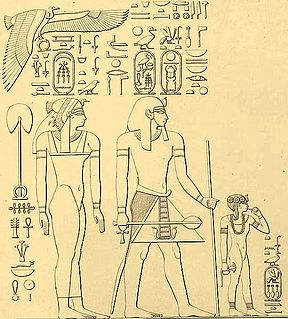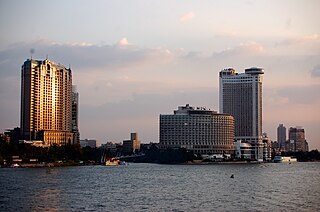
Ahmose I was a pharaoh and founder of the Eighteenth Dynasty of Egypt. He was a member of the Theban royal house, the son of pharaoh Seqenenre Tao and brother of the last pharaoh of the Seventeenth dynasty, Kamose. During the reign of his father or grandfather, Thebes rebelled against the Hyksos, the rulers of Lower Egypt. When he was seven years old, his father was killed, and he was about ten when his brother died of unknown causes after reigning only three years. Ahmose I assumed the throne after the death of his brother, and upon coronation became known as nb-pḥtj-rꜥ "The Lord of Strength is Ra".

Ahmose was an Ancient Egyptian queen in the Eighteenth Dynasty. She was the Great Royal Wife of the dynasty's third pharaoh, Thutmose I, and the mother of the queen and pharaoh Hatshepsut. Her name means "Born of the Moon".

Thutmose I was the third pharaoh of the 18th dynasty of Egypt. He received the throne after the death of the previous king, Amenhotep I. During his reign, he campaigned deep into the Levant and Nubia, pushing the borders of Egypt farther than ever before. He also built many temples in Egypt, and a tomb for himself in the Valley of the Kings; he is the first king confirmed to have done this.

Tetisheri was the matriarch of the Egyptian royal family of the late 17th Dynasty and early 18th Dynasty.

Ahmose-Nefertari of Ancient Egypt was the first Queen of the 18th Dynasty. She was a daughter of Seqenenre Tao and Ahhotep I, and royal sister and the great royal wife of pharaoh, Ahmose I. She was the mother of king Amenhotep I and may have served as his regent when he was young. Ahmose-Nefertari was deified after her death.

God's Wife of Amun was the highest-ranking priestess of the Amun cult, an important religious institution in ancient Egypt. The cult was centered in Thebes in Upper Egypt during the Twenty-fifth and Twenty-sixth dynasties. The office had political importance as well as religious, since the two were closely related in ancient Egypt.

Ahmose-Meritamun was a Queen of Egypt during the early Eighteenth dynasty of Egypt. She was both the sister and the wife of Pharaoh Amenhotep I. She died fairly young and was buried in tomb TT358 in Deir el-Bahari.

Pinedjem II was a High Priest of Amun at Thebes in Ancient Egypt from 990 BC to 969 BC and was the de facto ruler of the south of the country. He was married to his sister Isetemkheb D and also to his niece Nesikhons, the daughter of his brother Smendes II. He succeeded Smendes II, who had a short rule.

Ahmose-Sitamun or Sitamun was a princess of the early Eighteenth dynasty of Egypt.
Ahmose-Sapair was a prince of the early Eighteenth Dynasty of Egypt. He was probably a son of Pharaoh Amenhotep I and is shown with him on several stelae and also on a wall fragment from the tomb of the gardener, Nakht, [TT161], which is now in Brussels. A now lost inscription above it, naming the two individuals, was copied and preserved by Hays. Ahmose-Sipair is not to be confused with another prince named Ahmose, who was the son of Seqenenre Tao and who has a beautiful statue dedicated to him by his family members. The inscription on the statue does not contain the secondary name of Sipair [son of the eye of Horus], however. Both princes are probably depicted in a scene from the tomb of Inherkau [TT359]. Ahmose-Sipair is the last person in the first row of the defunct royals of ancient Egypt and there is another king's son shown in the second row. His entire name does not survive, only the element "ms", but as he is seated behind King Seqenenre, he is likely that ruler's lamented son, Prince Ahmose.

Ahmose-Inhapy or Ahmose-Inhapi was a princess and queen of the late 17th dynasty and early 18th dynasty.

Sitdjehuti was a princess and queen of the late Seventeenth dynasty of Egypt. She was a daughter of Pharaoh Senakhtenre Ahmose and Queen Tetisheri. She was the wife of her brother Seqenenre Tao and was the mother of Princess Ahmose.

Ahmose was a princess of the Seventeenth Dynasty of Egypt. She was the only known daughter of Seqenenre Tao by his sister-wife Sitdjehuti. She was the half-sister of Pharaoh Ahmose I and Queen Ahmose-Nefertari. Her titles are King's Daughter; King's Sister.

Ahmose-Henuttamehu was a princess and queen of the late 17th-early 18th dynasties of Egypt.
Ahmose-Meritamon was a princess of the 17th Dynasty of Egypt, probably a daughter of pharaoh Seqenenre Tao. She is also called Ahmose-Meritamun, Ahmose-Meryetamun or just Meryetamun.
Ahmose-Nebetta was a princess during the late seventeenth dynasty of Egypt. She was probably the daughter of Seqenenre Tao and Queen Ahhotep I. She was the sister of Pharaoh Ahmose I.

Ahmose-Sitkamose or Sitkamose was a princess and queen during the late 17th-early 18th dynasties of Egypt. Based on her name, she is likely to have been the daughter of Pharaoh Kamose. Her name means "daughter of Kamose".
Nauny or Nany was an ancient Egyptian princess during the Twenty-first dynasty, probably a daughter of High Priest, later Pharaoh Pinedjem I. The name of her mother, Tentnabekhenu is known only from Nauny's funerary papyrus.
The Eighteenth Dynasty of Egypt is classified as the first dynasty of the New Kingdom of Egypt, the era in which ancient Egypt achieved the peak of its power. The Eighteenth Dynasty spanned the period from 1549/1550 to 1292 BC. This dynasty is also known as the Thutmosid Dynasty for the four pharaohs named Thutmose.




















